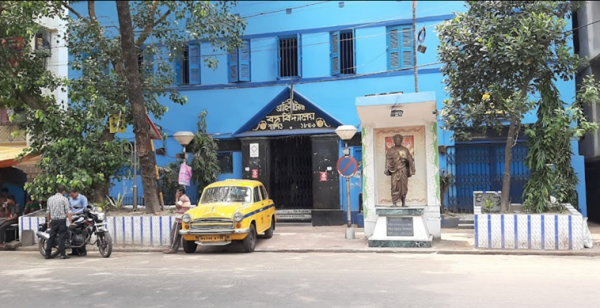More well-known by the ghat of the same name, the neighbourhood of Ahiritola in north Kolkata is one of the oldest in the city. The very narrow Ahiritola Street, only wide enough to accommodate one auto-rickshaw at a time, finds mention in some of the oldest maps of the city of Calcutta, including British lithographer Mark Wood’s map of 1784. But in these maps, the street’s name has been corrupted and anglicised and is mentioned as ‘Areetollah Street’.
Today, this street stretches from the crossing of B K Paul Avenue, all the way up to the Bhootnath Temple, just skirting the ghats on the Hooghly river. In his book ‘A History of Calcutta’s Streets’, historian P Thankappan Nair writes that lanes and bylanes branching off Ahiritola Street came into existence only after 1876. Here, Nair is specifically writing about the history of Ahiritola Bye Lane and Ahiritola 1st Lane, both very narrow lanes located deep inside Ahiritola Street that would be easy to miss if one were walking down the cramped path, not paying attention.
Today, this street stretches from the crossing of B K Paul Avenue, all the way up to the Bhootnath Temple, just skirting the ghats on the Hooghly river (Express photo by Neha Banka)
Nair attributes his findings to the fact that these two branching lanes do not find any mention in the city’s municipal directory of 1876, and can only be found in subsequent editions.
The street and the neighbourhood at large get their name from the ‘ahir’ community or milk vendors who belonged to the Bihari community. The term ‘tola’ means a neighbourhood or demarcated area. Old archives of the city indicate that the community resided in a substantial part of the neighbourhood and had settled here over the generations, which resulted in the name ‘Ahiritola’.
Subscriber Only Stories
 Ahiritola Ghat itself has a rich history associated with Ramakrishna Paramahansa and Rashmoni Das, popularly known as Rani Rashmoni, the widow of zamindar Rajachandra Das. (Express photo by Neha Banka)
Ahiritola Ghat itself has a rich history associated with Ramakrishna Paramahansa and Rashmoni Das, popularly known as Rani Rashmoni, the widow of zamindar Rajachandra Das. (Express photo by Neha Banka)
But it is a misconception that Ahiritola was exclusively a residential area for the city’s milkmen. Archives of the city indicate that while the neighbourhood’s name may have its origins in the community of milk vendors who had lived there, it was a relatively diverse neighbourhood that accommodated residences as well as commercial enterprises.
In their book ‘The Story of the Calcutta Theatres, 1753-1980’, authors Susilla Mukhopadhyaya and Sushil Kumar Mukherjee write that the neighbourhood of Ahiritola also accommodated the city’s theatre scene for several decades. In addition to theatre, the neighbourhood also accommodated brothels, similar to other neighbourhoods where the business flourished, author Biswanath Joardar writes in his book ‘Prostitution in Nineteenth and Early Twentieth Century Calcutta’. The author adds that within the hierarchy of the city’s business of sex work, it was usually daily-wage earners and labourers who visited sex workers in the brothels of Ahiritola.
 At the end of Ahiritola Street, just where it meets B K Paul Avenue, the 164-year-old government-run Ahiritola Banga Bidyalaya still stands, making it one of the oldest educational institutions still operating in the city (Express photo by Neha Banka)
At the end of Ahiritola Street, just where it meets B K Paul Avenue, the 164-year-old government-run Ahiritola Banga Bidyalaya still stands, making it one of the oldest educational institutions still operating in the city (Express photo by Neha Banka)
Delving into the history of Ahiritola indicates that like many of Kolkata’s oldest neighbourhoods, it is difficult to compartmentalise its development and associate it with only one trade or community or religious group. Even within the demarcations, both obvious and subtle, that were created for the city’s neighbourhoods by various entities over the years, the stories of the neighbourhoods are too complex, full of contrasts, and are interwoven to give these streets and lanes a unique identity of their own. While there was a thriving brothel operating here, the neighbourhood was home to several devotees of Hindu mystic Ramakrishna Paramahansa.
Advertisement
“It was in the quarters of Baghbazar, Simla and Ahiritola that many of the Master’s devotees lived. For this reason the Master would come on most occasions” to one of the several neighbourhoods in and around Ahiritola from Dakshineswar, located on the other side of the Hooghly river, writes Swami Jagadananda in his biography titled ‘Sri Ramakrishna: The Great Master’. The temple in Dakshineswar was easily accessible by boats available on the many ghats that dot the banks of the Hooghly on either side, making transport between the banks convenient.
Ahiritola Ghat itself has a rich history associated with Ramakrishna Paramahansa and Rashmoni Das, popularly known as Rani Rashmoni, the widow of zamindar Rajachandra Das. Following the death of her husband, Rani Rashmoni took over the management of the zamindari and funded several works of construction and philanthropic initiatives in Bengal. One of these philanthropic initiatives included the construction of three bathing ghats for pilgrims, Babughat, also known as Babu Rajchandra Das Ghat, Ahiritola Ghat and Nimtala ghat for everyday bathers at the banks of the Hooghly.
In its early days, Ahiritola was also a centre of the city’s publishing business. In his book titled ‘The Book: A Global History’, author Michael F Suarez, S J documents the writing systems and book history, delves a bit into the history of publishing in Calcutta and writes that in 1857, there were at least 46 presses in and around Ahiritola, including the areas of Garanhata, Chitpur and Barabazar, “which printed a wide range of genres such as almanacs, mythological literature, farces, songs, medical texts…”.
Advertisement
Author Nilanjan Chakraborty confirms this in his book ‘Myth Formation in the Fiction of Chinua Achebe and Amitav Ghosh’, where he highlights how a “vast number” of local presses began coming up in the “regions of Chitpur, Goranhata, Ahiritola, and Dorjipara – the quintessential northern part of the city that was marked as a “black town” by the British”.
In May 1939, there was a proposal to change the name of Ahiritola 1st Lane to ‘Kali Prosanna Banerjee Lane’, writes Nair, citing the Calcutta Municipal Gazette edition of that month, “and some of the residents of the locality protested against it. They maintained that the Lane was so called for 100 years….He was not a resident of Ahiritola 1st Lane, nor had any landed property of interest there.” Nair indicates for some unexplained reason, the city’s municipal corporation made a few more attempts over the subsequent years to change the street’s name but were not successful in any of their attempts.
At the end of Ahiritola Street, just where it meets B K Paul Avenue, the 164-year-old government-run Ahiritola Banga Bidyalaya still stands, making it one of the oldest educational institutions still operating in the city. Established in 1859, the school was formerly known as ‘Jadu Pandit-er Pathshala’ and the school’s archives say that the institution was established by the “active patronage” of educator and social reformer Iswar Chandra Vidyasagar. Although it is not clear when this happened, sometime over the past few decades, the school purchased the land it stands on from Calcutta Improvement Trust.
The school also finds mention in the letters and correspondence of Dr Rajendra Prasad, who served as the first President of India, where Dr Prasad offers wishes on the event of the school’s centenary celebrations in 1959. “On the occasion of its Centenary Celebrations I send my good wishes to the Ahiritola Banga Bidyalaya, which can claim to be one of the oldest educational institutions”, in the country, Dr Prasad had written.
Source: https://news.google.com/__i/rss/rd/articles/CBMibGh0dHBzOi8vaW5kaWFuZXhwcmVzcy5jb20vYXJ0aWNsZS9jaXRpZXMva29sa2F0YS9zdHJlZXR3aXNlLWtvbGthdGEtYmF0aGluZy1naGF0LWFoaXJpdG9sYXMtaGlzdG9yeS04NDA3MjYwL9IBcWh0dHBzOi8vaW5kaWFuZXhwcmVzcy5jb20vYXJ0aWNsZS9jaXRpZXMva29sa2F0YS9zdHJlZXR3aXNlLWtvbGthdGEtYmF0aGluZy1naGF0LWFoaXJpdG9sYXMtaGlzdG9yeS04NDA3MjYwL2xpdGUv?oc=5

